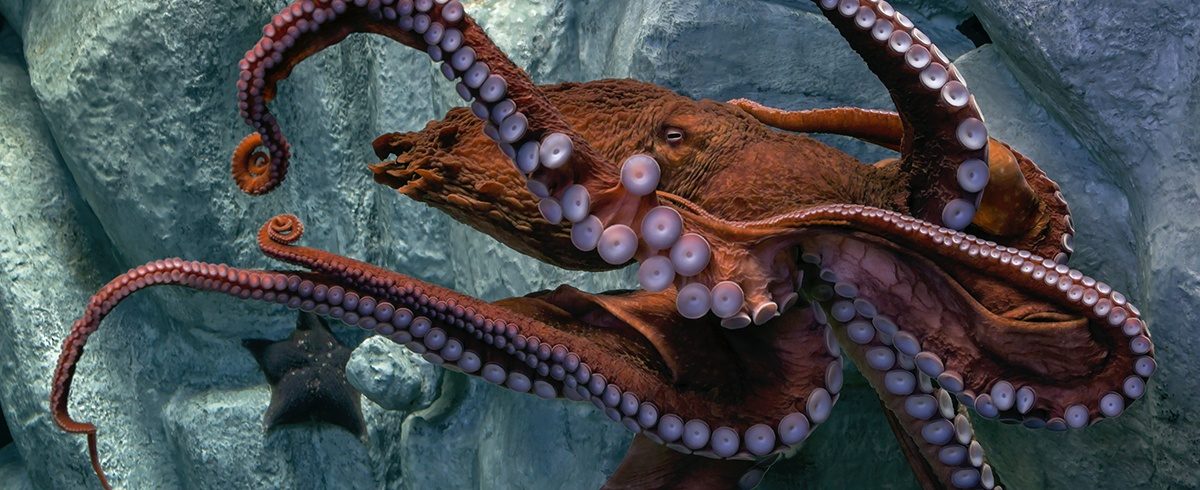
#Giant pacific octopus plus#
The giant octopus has a reddish-brown body, called the mantle, plus four pairs of arms, measuring on average about 4.9 m long. Video can’t be loaded because JavaScript is disabled: An Encounter With a Giant Pacific Octopus Septem() Frequently Asked Questions (FAQs) INTERVIEWS.Marine Biology Degree Programs Worldwide.Marine Biology Degree Programs in the U.S.Geological Makeup of Marine Environments.Worldwide Aquariums and Marine Life Centers.Ocean Mysteries: Did Life begin in the Ocean?.Marine Biology Laboratories, Institutes & Graduate Programs.Marine Science/Ocean Life Related Journals.A History of the Study of Marine Biology.Status: Not currently under the protection of CITES or the IUCN Red List. It is found throughout the Pacific Ocean from Baja California, north along the coastline, across the Aleutians and south to Japan. Habitat/range: The Giant Pacific octopus lives in dens or lairs, under boulders, rock crevices or caves. Females only breed once in their lifetime males may breed with several females. At the end of the stage they will settle on the bottom and undergo rapid growth. After hatching, the larvae move to the surface where they spend about 4-12 weeks in a planktonic stage.

While the female tends to the eggs, she does not eat, therefore she dies once the eggs hatch or shortly thereafter. Cooler temperatures delay the development of the embryos. The incubation period can take 150 days to seven or more months depending on water temperature. These clusters are usually hung from the ceiling of their den and the female remains with the eggs cleaning and aerating them until they hatch. The female then lays 20,000 to 100,000 rice-shaped eggs in clusters over a period of several days. He uses this arm to transfer sperm into the female’s oviduct. Reproduction: The third right arm of the male is hectocotylized (modified) with a modified tip called the ligula. These two senses are facilitated by the thousands of chemical receptors in the suckers.Ĭommunication: The octopus can rapidly force water out of its body, propelling itself backwards to escape predators and warn others that danger is near. Focusing is done by the lens moving in and out. Senses: The sense of sight is well developed. The prey becomes paralyzed, the connective tissue dissolves and then it is pulled apart. The first method is pulling the shell apart to get at the ‘meat’ the second is crushing the prey with its strong beak the third and most common method is stabbing or drilling a hole into the shell and injecting its toxic saliva.

There are three methods of obtaining food that has been observed.

It mostly eats crabs and scallops, but will also consume abalone,Ĭlams, fish, shrimp and squid. It can also release a cloud of purple- black ink to confuse its predator.ĭiet: This octopus is a forager. When threatened, the octopus can change color to conceal itself. It is a solitary, timid creature and will often stay in its den for long periods of time, coming out only to eat, breed or escape danger. It uses its well- developed sense of sight to learn through observation, is able to solve problems by trial-and- error and experience and has long and short-term memory. The record weight for a Giant Pacific octopus is 600 pounds (272 kg).īehavior: The Giant Pacific octopus is an extremely intelligent creature. Adults weigh 50 to 90 pounds (22.7 – 40.8 kg) and have an arm span up to 16 feet (4.9m). Size: This octopus is one of the largest species of octopods.
#Giant pacific octopus skin#
It is able to change color and texture of its skin by contracting or expanding tiny pigments ( chromatophores) in its cells, thus giving it the ability to blend into its surroundings. Each arm has two alternating rows of suckers, about 280, that contain thousands of chemical receptors. It has four pairs of arms with suckers that extend from the mantle. The spherical body (mantle) contains most of its vital organs and the sharp, beak-like mouth that is used to kill its prey. Description: The Giant Pacific octopus ( Enteroctopus dofleini) is usually reddish-brown in color, has a sack-like body and a bulbous head with two eyes, one on each side.


 0 kommentar(er)
0 kommentar(er)
